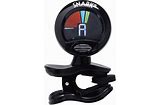
I’m all in favor of learning to tune by ear, but when you’re starting out, it’s probably more important to get your guitar in tune quickly so you can spend more time learning to play.
An electronic tuner listens to your open string and tells you what note you’re tuned to, usually using a horizontal dial that swings left when you’re too low, and right when you’re too high.
With this type of tuner, you know you’re in tune when it displays the correct note name and gives you an arrow that’s straight up the middle.
To get started, just pluck the open string, reach over and find the correct tuning peg, and then turn it slowly while the string is still ringing. If you go slowly and watch the tuner’s display, you can see if you’re getting closer to the middle of the dial or farther away.
String Names
You’ll need to know the string names: E A D G B E. That’s counting from the 6th string (the lowest-pitched bass string) to the 1st string (the highest-pitched treble string). It helps to play the strings in order, either 1-2-3-4-5-6 or 6-5-4-3-2-1, rather than jumping around, so you don’t mix up which strings you’ve tuned and which ones still need to be adjusted.
Common Problems:
1. You can be perfectly in tune to the wrong note.
Make sure the note name on the tuner matches the correct note name for the string, without any “b” or “#” symbol after it. There are usually three versions of each note: flat, sharp, and natural. Ab is A-flat. A# is A-sharp. A is A natural. You want all natural notes.
2. The tuner gives the wrong note name.
Sometimes your tuner will flip between two totally different notes for the same string, for example B and F#, seemingly at random. Try playing the 12th fret rather than the open string. It’s the same note, played an octave higher, and in some cases, the tuner will hear that note more clearly than the open string.
Or better yet, play a harmonic on the 12th fret. Lightly touch the string directly over the fret and pop your finger off just after you pluck the string. It helps to position your pick close to the bridge (where your strings attach to the body of the guitar). A harmonic is a high-pitched, chiming version of the open string note and leaves both of your hands free to adjust the tuning.
Why Use An Electronic Tuner?
In the long run, tuning by ear will be more valuable, since it teaches you to listen closely and develop your musical ear, but for right now, it’s more important to get your guitar sounding good quickly, so you can focus on learning the hand skills that guitar requires – using the tips of your fingers on the strings, strumming, and always stretching out to get close to the fret.
Plus, a clip-on or plug-in electronic tuner will help you get in tune anywhere, even in a noisy environment. Music is often a social event, and if you want to share your music with others, it’s a GOOD sign when you can’t hear very well: it means you have lots of folks to play for. But a crowd does make tuning by ear difficult, so get good at using your tuner.